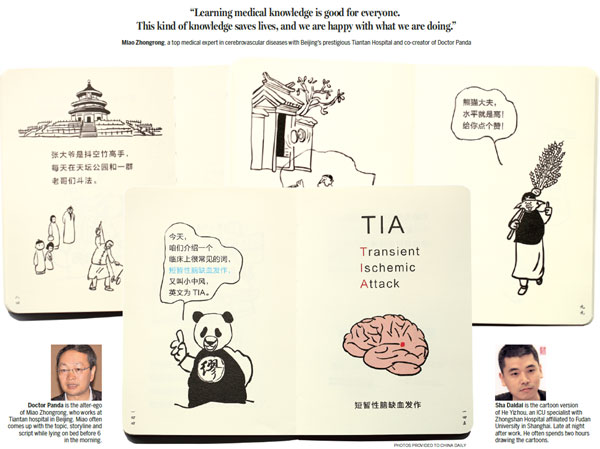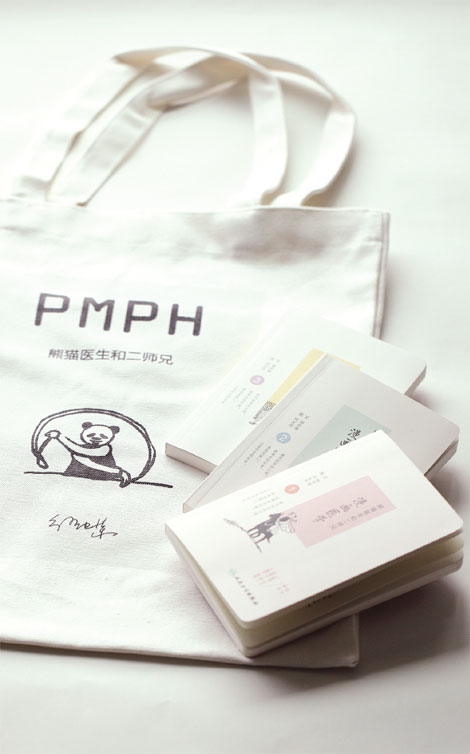Life
Medical advice that will have you in stitches
Updated: 2016-08-09By Liu Zhihua ( China Daily USA )
Two doctors hit the funny bone as they endeavor to educate
His formal name is Ailuropoda melanoleuca, which may be enough to scare you off, but behind that fancy moniker is the most docile, unpretentious of creatures, a giant panda, and he has bestowed on himself the title of doctor.
Dr Panda's mission in life is simple: Just as he prefers simplicity in his name, he is keen to deliver us from medical mumbo jumbo so that we have a clear idea about our bodies, their illnesses and how to prevent and heal them, and an essential element of his manner is humor.

Dr Panda is the central character in the Little Doctor Cartoons, a series posted on a WeChat public account that has more than 70,000 subscribers, each story having thousands of readers, and many of them more than 10,000 readers.
The central character, with the cuddliness and cuteness that only a giant panda can exude, is from the mountains of Lanzhou, Gansu province, and loves eating Lanzhou lamian and runs a restaurant in Beijing that specializes in the famous noodles.
His clientele come from all over the country, and when he has time he chats with his friend Sha Daidai, literally the silly one, but their conversation is often interrupted by patients coming to the restaurant seeking medical help.
Sometimes when there are no patients, Dr Panda talks with friends about medical issues they have encountered. Sha Daidai, who is also called Er Shixiong because he looks like the pig monk Zhu Bajie (Er Shixiong) in the 16th-century novel Journey to the West, often asks questions, and Dr Panda dutifully supplies the answers.
The number of subscribers to the WeChat account has grown rapidly since the cartoons first went online in March, by about 10,000 a month, according to WeChat statistics.
"Reading Little Doctor Cartoons is one of the most enjoyable things for me in a day," says a reader surnamed Cao.
"The character illustrations are simple but really lifelike. Coupled with the humorous conversation, the cartoon makes dry, hard-to-understand medical information funny and easy to remember."
One of the most recent stories that was particularly popular was titled "A few things about appendicitis", posted on July 31, which has attracted more than 12,500 readers.
One sweltering summer's day Dr Panda and Sha Daiai are chatting in the restaurant when suddenly someone comes in asking for help. He has excruciating pain in his lower right abdomen and suffers from fever, nausea and vomiting.
Dr Panda examines the man and determines that he has appendicitis. Sha Daidai then starts asking questions such as what appendicitis is, the cause, the symptoms, methods of diagnosis, treatment and the prognosis.
In the end Sha Daidai takes off his clothes to reveal a small scar, a remnant of an appendectomy - which to you, me and Dr Panda is an operation to have the appendix removed.
In the cartoon panels Sha Daidai is depicted asking each of his questions as he contorts his body into outlandish positions and wears different facial expressions. Dr Panda answers in plain, concise language that is accompanied with easy-to-understand illustrations elucidating what he says.
As with other stories, many readers use the comments section to talk of their experience with similar ailments and express their thanks for what the cartoons have taught them.
The cartoons are the idea of two doctors, Miao Zhongrong and He Yizhou: The two main characters are their alter egos. Miao, alias Dr Panda, is an expert in cerebrovascular diseases at Tiantan Hospital in Beijing, and He Yizhou, alias Sha Daidai, is an ICU specialist at Zhongshan Hospital in Shanghai, which is linked with the city's Fudan University.
Miao, who writes the scripts, says he often does so while lying in bed before 6 am.
He then writes down other ideas and sends everything to He in Shanghai.

He, who by that time will be on his way to the hospital with an extremely busy day ahead of him, will then think about the details of characters' expressions and movements to accompany the scripts.
After returning home, usually late at night, he draws the cartoons, which usually takes two hours, he says.
Although the stories in the cartoons are fictional, most are based on the authors' experiences, Miao says.
The authors' doctor friends and patients inspire them. Such is the case with a pharmacist in the cartoon called Niu, Miao say.
"Acquiring medical knowledge is good for everyone," Miao says. "This kind of knowledge can save lives, and we are happy with what we are doing."
Cartoons help doctors to communicate with patients, explaining to them their medical issues and treatment, or making them feel better, he says.
He Yizhou says he has loved reading cartoons since he was young, and started drawing them in about 1999, and became further fascinated with them two years later while studying for his master's degree.
He set up the WeChat public account Little Doctor Cartoons in the spring of 2014, after posting cartoons on other platforms, including online blogs and social media.
At first his cartoons focused on his observations about the work and life of doctors, introductions to medical experts and health education.
This year, at the suggestion of a mutual friend, Miao and He started working together on the cartoons, focusing on health education.
The pair say China lacks health education materials that cover a broad range of topics and are interesting for ordinary people, and this is something they are keen to help remedy.
Miao, who is a board member and director with national medical associations in the fields of stoke, cerebrovascular disease and neurology, says: "People need accurate medical information, but China invests very little in public health education, and Chinese patients know little about disease prevention and treatment."
In developed countries health education brochures with interesting graphics or cartoons that help people easily understand the issues of disease prevention and treatment are widely available, but this is not so in China, Miao says.
Chinese hospitals are bothered with disputes between patients and their staff that sometimes turn to violence, and Miao says that if accurate and clear medical information were more readily available there would be fewer of these incidents.
Chinese often have unrealistically high expectations about doctors' abilities to offer remedies, and this can cause tension in the doctor-patient relationship when outcomes are disappointing, he says.
Patients often try all they can to get into the best hospitals and expect good results, but not all diseases are curable, and sometimes it can even be difficult to correctly diagnose conditions, Miao says.
"As Hippocrates said, 'Cure sometimes, treat often, comfort always'. Despite patients' best hopes, doctors are not almighty, but many patients are unaware of this. It is important for doctors to be able to give information to patients in an easy-to-understand way. We hope to make medicine knowledge easy and more accessible to every one."
He Yizhou says he hopes eventually the cartoons can be translated into other languages and they will endure for decades to come, just like the Merck Manual of Diagnosis and Therapy, the oldest continuously published English-language medical textbook.
liuzhihua@chinadaily.com.cn
|
Cartoon books Doctor Panda and Er Shixiong: Cartoons on Medicine and Health 1-3 are very popular among readers. Provided to China Daily |
(China Daily USA 08/09/2016 page10)



